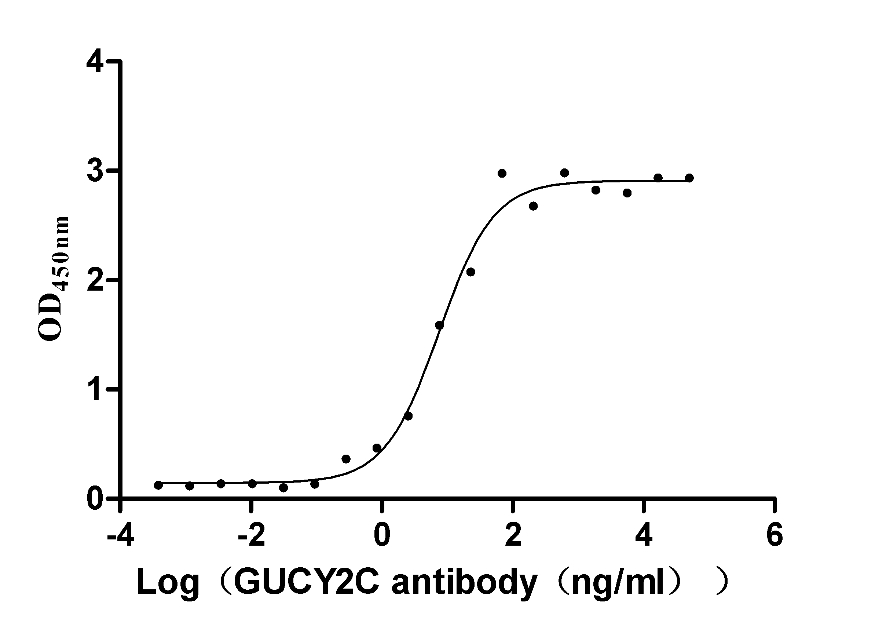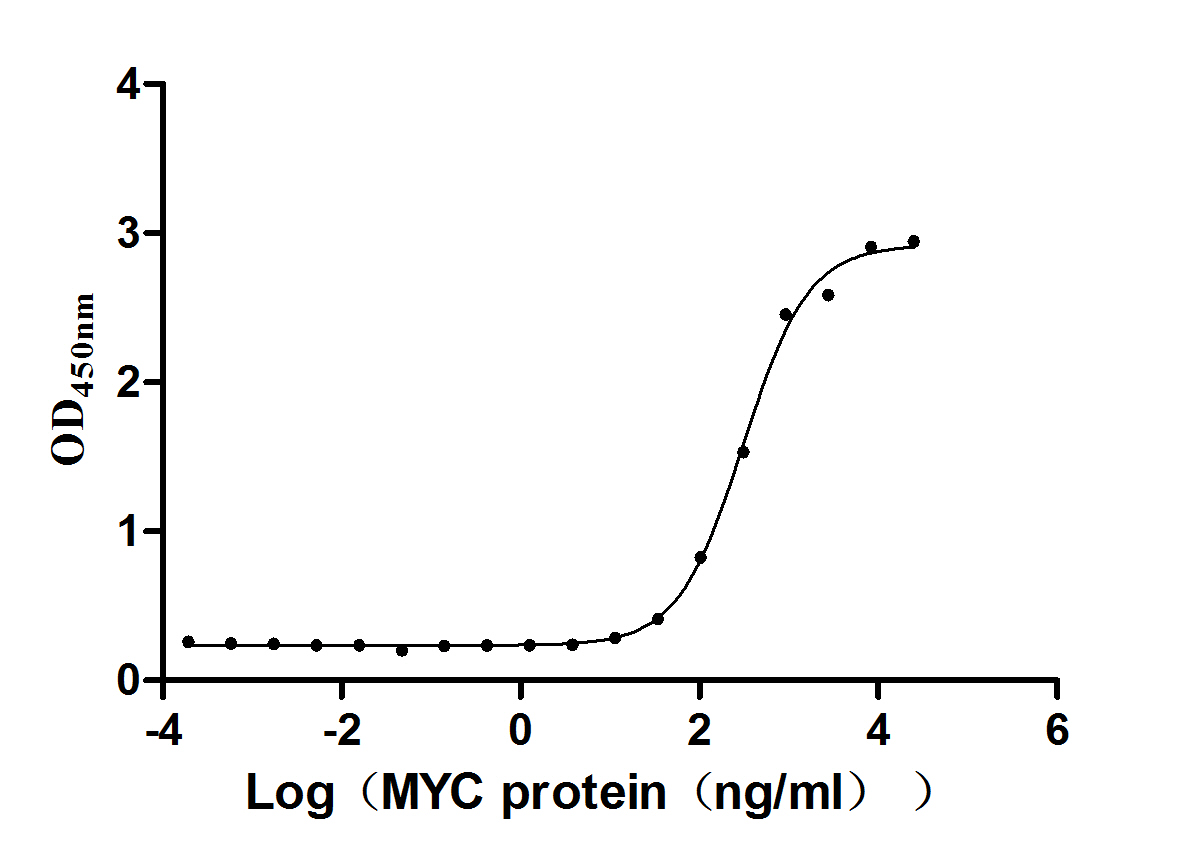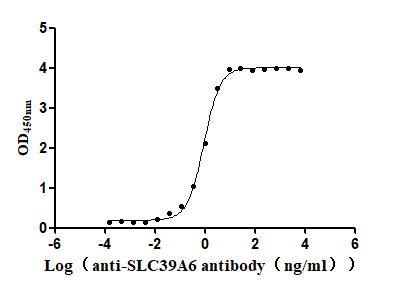Recombinant Human Beta-1 adrenergic receptor (ADRB1), partial
-
货号:CSB-EP001391HU
-
规格:
-
来源:E.coli
-
其他:
-
货号:CSB-EP001391HU-B
-
规格:
-
来源:E.coli
-
共轭:Avi-tag Biotinylated
E. coli biotin ligase (BirA) is highly specific in covalently attaching biotin to the 15 amino acid AviTag peptide. This recombinant protein was biotinylated in vivo by AviTag-BirA technology, which method is BriA catalyzes amide linkage between the biotin and the specific lysine of the AviTag.
-
其他:
-
货号:CSB-BP001391HU
-
规格:
-
来源:Baculovirus
-
其他:
-
货号:CSB-MP001391HU
-
规格:
-
来源:Mammalian cell
-
其他:
产品详情
-
纯度:Greater than 85% as determined by SDS-PAGE.
-
基因名:Name:ADRB1Synonyms:ADRB1R, B1AR
-
Uniprot No.:
-
别名:ADRB1; ADRB1R; B1AR; Beta-1 adrenergic receptor; Beta-1 adrenoreceptor; Beta-1 adrenoceptor
-
种属:Homo sapiens (Human)
-
蛋白长度:Partial
-
表达区域:378-477
-
氨基酸序列CRSPDFRKAFQRLLCCARRAARRRHATHGDRPRASGCLARPGPPPSPGAASDDDDDDVVG ATPPARLLEPWAGCNGGAAADSDSSLDEPCRPGFASESKV
-
蛋白标签:Tag type will be determined during the manufacturing process.
The tag type will be determined during production process. If you have specified tag type, please tell us and we will develop the specified tag preferentially. -
产品提供形式:Lyophilized powder
Note: We will preferentially ship the format that we have in stock, however, if you have any special requirement for the format, please remark your requirement when placing the order, we will prepare according to your demand. -
复溶:We recommend that this vial be briefly centrifuged prior to opening to bring the contents to the bottom. Please reconstitute protein in deionized sterile water to a concentration of 0.1-1.0 mg/mL.We recommend to add 5-50% of glycerol (final concentration) and aliquot for long-term storage at -20℃/-80℃. Our default final concentration of glycerol is 50%. Customers could use it as reference.
-
储存条件:Store at -20°C/-80°C upon receipt, aliquoting is necessary for mutiple use. Avoid repeated freeze-thaw cycles.
-
保质期:The shelf life is related to many factors, storage state, buffer ingredients, storage temperature and the stability of the protein itself.
Generally, the shelf life of liquid form is 6 months at -20°C/-80°C. The shelf life of lyophilized form is 12 months at -20°C/-80°C. -
货期:Delivery time may differ from different purchasing way or location, please kindly consult your local distributors for specific delivery time.Note: All of our proteins are default shipped with normal blue ice packs, if you request to ship with dry ice, please communicate with us in advance and extra fees will be charged.
-
注意事项:Repeated freezing and thawing is not recommended. Store working aliquots at 4°C for up to one week.
-
Datasheet :Please contact us to get it.
相关产品
靶点详情
-
功能:Beta-adrenergic receptors mediate the catecholamine-induced activation of adenylate cyclase through the action of G proteins. This receptor binds epinephrine and norepinephrine with approximately equal affinity. Mediates Ras activation through G(s)-alpha- and cAMP-mediated signaling. Involved in the regulation of sleep/wake behaviors.
-
基因功能参考文献:
- There was no association of SNPs in ADRB1, GRK5 and BAG3 genes with Takotsubo cardiomyopathy. PMID: 29514624
- These results suggested that adrenergic stimulation via beta1- and beta2-adrenergic receptors in the human endolymphatic sac was involved in regulation of inner ear fluid ion homeostasis PMID: 28165045
- Arg389Gly polymorphism in ADRB1 is not associated with overweight, obesity or dyslipidaemias in Saudis PMID: 29587766
- This study provided proof that SNPs within ADRB1 is significantly associated with the susceptibility to and the prognosis of cervical vertigo, so that NPY and NA might serve as the precise diagnostic marker and treatment target of cervical vertigo. PMID: 29197114
- Report associations between ADRB1 SNPs and acute coronary syndrome/cardiovascular risk factors in Arab population. PMID: 26602751
- The downregulation of beta-ARs after ureter dilation, particularly for beta1-AR and beta3-AR in the muscular layer, suggests a potential compensatory mechanism involving increased contraction of the ureter to push urine through the obstruction. PMID: 28756611
- The results demonstrate that Gly/Gly polymorphism in Arg389Gly ADRB1 was an independent risk factor for hypertension; moreover, the patients who carried the Gly389Gly genotype had a significantly improved metoprolol antihypertensive effect than those with ADRB1. PMID: 29549925
- All patients carrying the Val158-COMT allele exhibited higher preoperative norepinephrine concentrations. Moreover, we found that both beta1-adrenoceptor polymorphisms were associated with a longer stay in hospital. We conclude that patients with the Val158-COMT genotype exhibit higher endogenous resting plasma norepinephrine levels. PMID: 28522796
- two barcodes are involved in sorting Wild Type ss1-AR out of early endosomes. PMID: 27816670
- For adrenergic receptors, a potential dimer interface involving transmembrane domain 1 (TMD1) and helix 8 (H8) was identified in crystal structures of the beta1-adrenergic (beta1-AR) and beta 2-AR PMID: 27993566
- Data suggest that the partial agonist STD-101-D1 of beta-1 adrenergic receptor (ADRB1) is an research tool to study mechanisms of G protein-coupled receptor signal transduction. PMID: 28746336
- Analyzing the functional relevance of individual sites using phosphosite-deficient receptor mutants we found phosphorylation of the ADRB1 at Ser461/Ser462 in the distal part of the C-terminus to determine beta-arrestin2 recruitment and receptor internalization PMID: 28472170
- Studied frequency of ADRB1 Arginine389Glycine (Arg389Gly) and Cytochrome p450 2D6*10 (Cyp2D6*10) polymorphism in cases of heart failure-reduced ejection fraction (HFREF), and to evaluate the influence of the polymorphisms in response to beta-blocker (BB) therapy; found a statistically significant association was observed with CC genotype and Glisin-Glisin (GG) genotype. PMID: 27665326
- Selective alpha1-adrenergic receptor blockade provoked disturbances in the distribution of regional cerebral blood flow that resulted in significant changes in ipsilateral hemispheric blood flow and conductance during static handgrip exercise. PMID: 27016578
- Among individuals with previous small artery ischemic stroke, the ADRB1 Gly49 polymorphism was associated with major adverse cardiovascular events, particularly small artery ischemic stroke, a risk that may be increased among beta-blocker-treated individuals. PMID: 28351962
- ADRB1 SNPs were associated with myocardial infarction susceptibility, blood pressure and plasma lipids. PMID: 28456594
- the beta adrenoreceptor Gly 49 allele of the beta1 -adrenergic receptor Ser(49) Gly polymorphisms may increase the risk of implantable cardioverter-defibrillators shock in patients with heart failure, independent of beta-blocker dosage PMID: 27027728
- This study demonstrates that the polypeptide GalNAc-transferase 2 (GalNAc-T2) specifically O-glycosylates beta 1-adrenergic receptor at five residues in the extracellular N terminus, including the Ser-49 residue at the location of the common S49G single-nucleotide polymorphism. PMID: 28167537
- The minor alleles of ADRB1 and ADRB3 were significantly underrepresented in kinesiology students compared with nonmajors. PMID: 28177749
- The ADRB1 Gly389X genotype showed greater response to bisoprolol than the Arg389Arg genotype, suggesting the potential of individually tailoring beta-blocker therapy according to genotype in Korean heart failure patients. PMID: 26879662
- The multiplex SNaPshot method allows for specific and accurate detection of CYP2D6 genotypes and ADRB1 genotypes and haplotypes. This platform is simple and efficient and suited for high throughput. PMID: 27108086
- Suggest a common regulatory pattern for the beta(1)-AR/GRK5 which is independent of cellular type or pathology. PMID: 26248277
- In healthy individuals, heart rate and renin responses to dobutamine were more than three-fold greater among ADRB1 Arg389 compared with Gly389 homozygotes. PMID: 26313487
- ADRB1 is associated with heart rate recovery after exercise. PMID: 26058836
- Ser49Gly polymorphism of the ADRB1 gene confer higher risk of ischemic stroke in a North Indian population. PMID: 25510377
- the b1 adrenergic receptor gene Arg389Gly polymorphism might not be associated with heart failure risk PMID: 26125791
- There was no significant interaction between the effects of ADRB1 and CYP2D6 gene polymorphisms on treatment outcome. Patients homozygous for the mutant ADRB1 genotype (CC) had better treatment outcomes than those heterozygous for the mutation (GC). PMID: 25823457
- In women with mitral valve prolapse syndrome, symptoms at least partially may be related to beta1-adrenergic receptor polymorphism, which has been shown previously to be associated with a hyperresponse to adrenergic stimulation. PMID: 25172623
- This study sought to identify the distributed characteristics of these variant genotypes in Chinese population, and influence of GRK5 and ADRB1 polymorphisms on systolic heart failure morbidity. PMID: 25638254
- This evidence, in combination with clinical studies, may contribute to a detailed analysis of the pattern of susceptibility to CVD involved in b-ADR1 receptor mechanism failure. PMID: 25815601
- Higher serum anti-M2-R and anti-beta1-R levels are associated with lone paroxysmal atrial fibrillation. PMID: 25351416
- The variant Arg389Gly of ADRB1 was statistically associated with an increase of LDL PMID: 24972470
- negative cooperativity across a beta1-adrenoceptor homodimer may be responsible for generating the low-affinity pharmacology of the secondary beta1-adrenoceptor conformation PMID: 25837585
- beta2-Stimulation is, therefore, more arrhythmogenic than beta1-stimulation in heart failure. PMID: 25673629
- Our data suggest that PIST contributes to the fine-tuning of b1AR sorting both during biosynthetic and postendocytic trafficking PMID: 25614626
- Arg389 polymorphism of the ADRB1 gene and Gln27 polymorphism of the ADRB2 gene were associated with the hypotensive response to topic betaxolol in healthy Mexican volunteers. PMID: 24749907
- differences in interhelical interaction regulate the different activation speed and efficacy of ADRB1 variants PMID: 25451930
- The possible link between beta 1-AR Gly389Arg and Ser49Gly polymorphisms and echocardiography parameters in 165 normotensive patients with a thyrotoxicosis without any cardiovascular disorders, was investigated. PMID: 24982877
- There is a direct correlation between Heart Rate and Systolic blood pressure in hypertensive patients with overweight and obesity from polymorphism Arg389Gly of ADRbeta1 gene. PMID: 25558679
- Bucindolol prevented new-onset AF; beta and alpha(2c) polymorphisms predicted therapeutic response; and the 47% of patients who were beta389 Arg homozygotes had an enhanced effect size of 74%. PMID: 24159564
- The beta1 -AR Arg389/Gly polymorphism may be associated with increased risk of orthostatic hypotension in female hypertensive patients. PMID: 24552127
- Data indicate mutation of the beta1 adrenergic receptor (beta1AR) promotes sustained agonist-induced cAMP activity, protein kinase A (PKA) phosphorylation, and cardiac myocyte contraction response. PMID: 24713698
- Co-expression of COX2 and beta1AR lowers the expression of COX2 in a dose-dependent manner. Stimulation of the receptor does not reverse the beta1AR-induced decrease in COX2, suggesting that this effect does not occur via classical beta1-signaling pathways. PMID: 25091480
- High Beta1 adrenergic receptor expression is associated with peripartum cardiomyopathy. PMID: 24466231
- beta1 and beta3-adrenergic receptors were expressed in retinal endothelial cells while beta2-adrenergic receptor was not detectable both at protein and mRNA levels. PMID: 24885710
- The Arg389Gly polymorphism of the ADRB1 gene may be a worthy biological marker to predict the risk of developing cardiovascular diseases given a high-risk atherogenic index PMID: 24371822
- S49G and R389G polymorphisms of the beta-adrenergic receptor influence signaling via the cAMP-PKA and ERK pathways. PMID: 24151242
- Data did not support a relationship between the three polymorphisms of ADRB1 (rs1801253) and ADRB2 (rs1042713 and rs1042714) genes and risk of subsequent cardiovascular events after PCI in Han Chinese patients with CAD. PMID: 24342311
- ADRB1 genetic polymorphisms did not influence left ventricular reverse remodeling after cardiac resynchronization therapy. PMID: 23729404
- Our findings indicate a novel function for beta1AR-mediated beta-arrestin1 signaling activated by carvedilol in miR biogenesis. PMID: 24334028
显示更多
收起更多
-
亚细胞定位:Cell membrane; Multi-pass membrane protein. Early endosome.
-
蛋白家族:G-protein coupled receptor 1 family, Adrenergic receptor subfamily, ADRB1 sub-subfamily
-
数据库链接:
HGNC: 285
OMIM: 109630
KEGG: hsa:153
STRING: 9606.ENSP00000358301
UniGene: Hs.99913
Most popular with customers
-
Recombinant Human Heat-stable enterotoxin receptor (GUCY2C), partial (Active)
Express system: Mammalian cell
Species: Homo sapiens (Human)
-
Recombinant Human papillomavirus type 16 Protein E7 (E7) (Active)
Express system: E.coli
Species: Human papillomavirus type 16
-
Recombinant Human Angiopoietin-2 (ANGPT2) (Active)
Express system: Mammalian cell
Species: Homo sapiens (Human)
-
Recombinant Human Epithelial discoidin domain-containing receptor 1 (DDR1), partial (Active)
Express system: Mammalian cell
Species: Homo sapiens (Human)
-
Recombinant Human Kidney-associated antigen 1(KAAG1) (Active)
Express system: Baculovirus
Species: Homo sapiens (Human)
-
Recombinant Macaca fascicularis Zinc transporter ZIP6 isoform X1(SLC39A6),partial (Active)
Express system: Baculovirus
Species: Macaca fascicularis (Crab-eating macaque) (Cynomolgus monkey)
-
Recombinant Human Tumor necrosis factor ligand superfamily member 15(TNFSF15) (Active)
Express system: Mammalian cell
Species: Homo sapiens (Human)
-
Express system: Mammalian cell
Species: Homo sapiens (Human)




-AC1.jpg)



-AC1.jpg)











